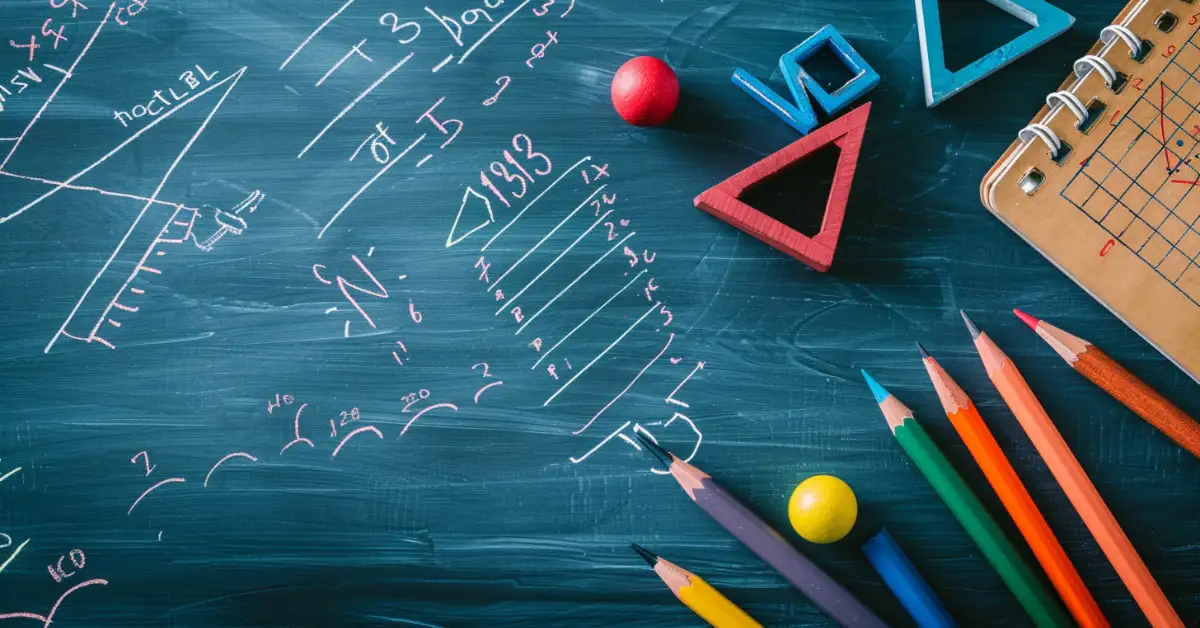Contemporary math demystifies how mathematics applies to real-world problems, moving beyond traditional subjects like calculus or algebra. This article quickly unpacks contemporary math’s role in everyday life and professional contexts, highlighting its focus on practical applications such as critical thinking and data analysis. Discover how contemporary math equips you with essential skills for a variety of fields, ensuring you understand and utilize math’s relevance in modern society.
What is Contemporary Math?
You are asking: What is Contemporary Math? Here is all in short!
| Feature | Description |
|---|---|
| Problem-Solving | Teaches systematic approaches to tackle complex issues. |
| Critical Thinking | Encourages evaluation of arguments and drawing evidence-based conclusions. |
| Applications | Utilizes mathematics in various disciplines and real-world scenarios. |
| Technology | Integrates modern tools to enhance learning and application of mathematical concepts. |
| Collaboration | Often involves group work to solve problems, reflecting real-world team-based tasks. |
Our approach to contemporary math is built on nurturing critical thinking. This means we often evaluate different arguments, make informed judgments, and use evidence to draw our conclusions. The aim is to foster an environment where we’re not just learning formulas and theorems but also understanding how to apply them in various contexts.
Moreover, we embrace the integration of technology in contemporary math. This enables us to stay current with the latest advancements and provides a practical perspective on how mathematics impacts our daily technology use.
Fundamentals of Contemporary Mathematics
Exploring what is contemporary math, we recognize its focus on real-world applications and how it connects to various aspects of daily life. At its core, contemporary math examines the structure of sets and the systematic process of logic and reasoning.
Set Theory
Set theory is a fundamental component of contemporary mathematics, providing the groundwork for understanding collections of objects, simply referred to as sets. A set can include anything from numbers to symbols, and sets themselves can have interrelationships. We often visualize these relationships using tools such as Venn diagrams, which can effectively illustrate how sets intersect or relate to one another.
For example, consider the sets A = {1, 2, 3} and B = {3, 4, 5}. A Venn diagram can show us the intersection of these sets is the number 3—an element they share.

Logic and Reasoning
Logic and reasoning serve as the backbone of mathematical thinking, which includes proof and argumentation. Within contemporary math, we often apply these principles to assess the validity of statements and to solve problems with precise, well-founded solutions. Abstract thinking in logic allows us to discover new relationships and conclusions based on previously known information.
Consider the statement, “All the lights in the house are off.” If one light is found to be on, the initial statement is proven false using logical reasoning. Dissecting and understanding such logical structures is essential in contemporary mathematical practice.

Branches and Applications
When we explore what is contemporary math, we’re delving into a broad field that encompasses various branches each with their practical applications. These branches provide the tools we use to navigate problems in modern society and the professional world.
Algebra and Geometry
In contemporary math, algebra and geometry go hand in hand, forming the foundation for more complex mathematical concepts. Algebra introduces us to the language of mathematics through equations and inequalities, while geometry gives us the ability to visualize and solve real-world problems through shapes and forms.
- Algebra: Solves for unknowns, creates models for real-world scenarios.
- Geometry: Offers insight into spatial relations and properties of figures.
Probability and Statistics
Probability and statistics are pivotal in contemporary math as they allow us to measure uncertainty and make informed decisions based on data. Through probability, we can predict the likelihood of events, and statistics helps us to analyze and interpret data collected from various surveys and studies.
- Probability: Evaluate the likelihood of different outcomes.
- Statistics: Involves the collection, analysis, and interpretation of data.
Abstract Algebra and Number Theory
While these may seem less tangible, abstract algebra and number theory are at the core of many technological advancements and cryptographic systems. Abstract algebra deals with algebraic structures like groups, rings, and fields, providing a deeper understanding of mathematical concepts. Number theory, often referred to as the queen of mathematics, focuses on the studies of integers and their properties, playing a critical role in modern computer science.
- Abstract Algebra: Studies algebraic structures and their properties.
- Number Theory: Investigates properties of integers and their applications in cryptography.

Math in the Real World
As we explore what is contemporary math, it’s important to recognize how it applies to everyday situations, making it an invaluable tool across different aspects of life.
Finance and Economics
In the world of finance and economics, contemporary math aids in understanding trends and forecasting economic futures. For instance, we use probability to assess risk and determine insurance premiums, while algebra is fundamental in calculating loan payments. We also come across statistics that help us analyze economic data, making sense of vast numbers and variables. For budgeting and managing personal finances, arithmetic operations like addition and subtraction are essential, especially when handling taxes and long-term financial planning.
Health and Medicine
Turning our attention to health and medicine, we leverage contemporary math to improve patient care and public health outcomes. Biostatistics play a pivotal role in analyzing medical research data and determining the effectiveness of new treatments. Through epidemiological models, which often involve complex calculations, we can predict the spread of diseases and understand health trends, improving health management and policy decision-making.
Voting Systems and Apportionment
Finally, in the context of voting systems and apportionment, contemporary math ensures fair representation. The method of apportionment is used to allocate seats in a proportionate manner among various parties or states in a legislative body. On the other hand, voting theory, including ranking methods and preference schedules, helps us to determine the outcome that best represents the views of a collective. We rely on mathematical calculations to implement and evaluate these systems, ensuring the management of fair and equitable elections.
Critical Skills and Liberal Arts Integration
When we explore what is contemporary math, we’re delving into a field that uniquely bridges critical thinking skills with creative applications in liberal arts. It’s an engaging fusion meant to empower liberal arts majors with practical, analytical abilities and a profound appreciation for art and technology.
Critical Thinking Skills
In contemporary mathematics, critical thinking skills are paramount. Liberal arts courses tailored toward non-math majors emphasize these skills, ensuring that assignments and exercises are relevant and applicable to real-world scenarios. Students are often tasked with identifying patterns, analyzing data, and formulating logical arguments. For instance, they might scrutinize the mathematical underpinnings of voting methods to evaluate their fairness and impact on society, applying these concepts directly to modern social situations.
- Exercises:
- Develop arguments using statistical reasoning.
- Approach problem-solving with quantitative analysis.
- Projects:
- Investigate case studies where math informs ethical decision-making.
- Collaborate on presentations that articulate mathematical analyses on societal issues.
Art and Technology
In the intersection of art and technology, contemporary mathematics celebrates the fusion of analytical prowess with creative processes. Projects that integrate mathematics with art encourage liberal arts majors to apply geometric and algebraic concepts to create visually stunning works. Meanwhile, technology applications are woven into the curriculum to illustrate how digital tools can elevate mathematical understanding and artistic expression.
- Art:
- Develop geometry-inspired art pieces.
- Interpret mathematical patterns and concepts through visual arts.
- Technology:
- Utilize software to simulate mathematical models.
- Engage with interactive technology to craft and analyze mathematical designs.
Educational and Career Connections
As we explore what is contemporary math, it’s essential to recognize its broad applications in education and various career paths. This dynamic field offers tools that extend well beyond traditional boundaries, shaping the way we handle complex problems in both STEM fields and day-to-day business operations.
STEM Fields and Beyond
Contemporary mathematics serves as a cornerstone in STEM fields—science, technology, engineering, and mathematics—where it equips students and professionals with sophisticated approaches to address scientific inquiries and technological challenges. It’s not limited to just these areas though; the beauty of contemporary math lies in its versatility and universal applicability. For instance, by advancing knowledge on a collection of objects and their interactions, contemporary mathematics becomes an invaluable asset across disciplines, from the hard sciences to the social sciences.
- Examples:
- In contemporary biology, it helps model ecosystems.
- In computer science, it improves algorithms and data structures.
- In economics, it assists in forecasting financial markets.
The contributors to the field come from a wide variety of backgrounds, reflecting the interdisciplinary nature and the integral role of contemporary math across an expanding array of related fields.
Tools for Management and Operations
In the realm of business, contemporary mathematics provides a robust tool for management and operations. Here, its applications are concrete, helping solve real-life situations that managers and operators face daily. Techniques derived from contemporary math enable us to optimize resources, forecast trends, and make data-driven decisions.
- Tool Examples:
- Project Management: Critical Path Analysis and Gantt charts
- Operations: Inventory models, queuing theory, and linear programming
These mathematical methods are more than academic exercises; they are practical tools that directly influence the efficiency and profitability of businesses. By integrating these contemporary mathematical concepts, we empower our workforce with the ability to tackle complex challenges effectively.
FAQ – What is Contemporary Math
Is contemporary mathematics easy?
Contemporary mathematics varies in difficulty depending on the topic and individual. Some concepts may be accessible, while others require significant effort. Overall, it’s a blend of accessibility and complexity, offering challenges and rewards for those who engage with it.
Is contemporary math the same as college algebra?
Contemporary math and college algebra are distinct but related. College algebra focuses on equations, functions, and graphs, while contemporary math encompasses broader topics like logic, statistics, and discrete mathematics. Both are foundational courses in many curricula, but contemporary math typically covers a wider range of applications and concepts beyond algebra.
What is the easiest math class in college?
The perception of the “easiest” math class can vary depending on individual strengths and interests. Generally, introductory courses like college algebra or precalculus are often considered more accessible due to their focus on fundamental concepts and practical applications, making them suitable for a wider range of students.
What is contemporary math with applications?
Contemporary math with applications typically covers a range of mathematical topics relevant to everyday life and various fields. It often includes elements of logic, statistics, probability, finance, geometry, and sometimes discrete mathematics. The emphasis is on practical problem-solving and real-world applications rather than abstract theory.
If you found this blog post on the topic of “What is Contemporary Math” helpful, please take a moment to share your thoughts in the comments below. We value your feedback and would love to hear about your experience with this subject.
If you want to keep reading more from us, have a look at these articles.





